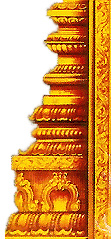| |
|
|
 | Singers: |  |
| |
|
|
| |
- |
|
| |
|
|
 |
Festival: |
 |
| |
|
|
| |
Nagaroottu worship, New Moon and Full day worships with special pujas are observed in the temple. |
|
| |
|
|
 |
Temple's Speciality: |
 |
| |
|
|
| |
Though a Shakti temple, Nagar worship – serpent deities – is prominent in the temple. |
|
| |
|
|
 |
Opening Time: |  |
| | | |
| |
The temple is open from 6.00 a.m. to 8.00 a.m. and from 5.00 p.m. to 7.00 p.m. |
|
| | | |
 |
Address: |  |
| | | |
| |
Sri Pazhanjira Devi Temple, Kovalam Road, Ambalathurai, Thiruvananthapuram. |
|
| | | |
 |
Phone: |  |
| | | |
| |
+91 471- 246 1037, 245 5204, 94474 00300 | |
|
| | |
 |
General Information: |  |
| |
|
|
| |
There are statues (idols) in the temple for Raktha Chamundi, Brahmma Rakshas and Madan Thamburan. 17 elephants and six lions are carrying the sanctum sanctorum. There are also idols for Mothers of Mummurthis – Lords Brahmma, Vishnu and Shiva and also one for Lord Shiva with Holy Ganga on the head. There are also Dasavathara sculptures in the temple. |
|
| |
|
|
 |
Prayers |  |
|
|
| |
| |
People pray to Sri Nagaraja in the temple with milk abishek for relief from vision and skin problems and for child boon. Those facing adverse aspects of the serpent planets Rahu and Ketu pray to Nagaraja for relief. They also pray to Sri Yogeeswara and use the sacred ash-Vibhuti Prasad for relief from the doshas – Bala Peetas – diseases affecting he children. | |
|
|
| |
 |
Thanks giving: |  |
|
|
| |
| |
Devotees offer Pongal-pudding nivedhana to Mother Devi with vastras, red flower garlands. They also fire crackers. | |
| |
| |
 |
Greatness Of Temple: |  |
| |
|
|
| |
The Masi festival in February-March begins in the temple on the Mrigasheersha star day with the singing of Thottra Pattu by those gifted with a sweet voice. This is a song in Malayalam. The songsters follow a fasting for 41 days prior to singing this song with strict disciplines. It is the staunch faith of the devotees that the very listening to the song with deep concentration would relieve them of the various evil effects around them and their family.
There is a Bothi tree-Arasamaram –Shenbaga tree and plants and creepers outside the temple called Sarpa Kavu. There is a 6 feet tall snake statue here praised as Nagaraja. People pray here for relief from vision and skin problems and for child boon. Those under the adverse influence of the serpent planets Rahu and Ketu worship here with milk abishek. They pray to Sri Yogeeswarar, use the Vibhti-sacred ash and apply on the children for protecting them from Child age diseases called Balarishta in astrology terms. They worship Mother Devi with red flower garlands, vastras and firing crackers.
Those scared of any critical illness of life threat to female children and to find a good and suitable match for them in future perform Kanni Puja dedicated to Mother Devi on the sixth night of Masi festival – Athazha puja. They dress girl children as Devi and perform this puja. Married women (sumangalis) also do this for the longevity of their Mangal Sutra Ashta Mangalya Puja. A puja called Sri Bhooda Bali also takes place on the day. A priest possessed with the influence of Mother Devi, wearing a tricolour silk vastra, anklets in the feet, holding a trident and sword walk backwards and offer the Bali for the Bhoodha Ganas.
Pongal festival on the seventh day of Masi festival coinciding with Pooram Star is an important event. Mother Pazhanjira Devi is very fond of Pongal. The pongal is prepared with hand pound rice got from earth and a bowl made of clay also from Earth, pour Water (Appu), use fuel to boil it (Agni), wind offering flames for the burning (Vayu), thus the elements making the world is explained in the Pongal offer philosophy. They also do the Nama Sangeerthanam chanting “Pazhangirai Devi Charanam”. Representing the Akasha Tattva, flowers are offered on the Pongal pot. The preparation of the Pongal in an open space also represents the Space Tattva.
|
|
| |
|
|
 |
Temple History: |  |
| |
|
|
| |
The present Thiruvananthapuram in Kerala was once a region of forests. A sage, Yogeeswarar by name performed deep penance on the banks of River Neelattrangarai on Devi for Her darshan. Mother Devi granted darshan to the sage and asked him to install Her in the place. The sage made an idol of Mother Devi in the form She granted darshan to him and installed her here. Later, forests were destroyed and a prison was built in the place. That also vanished in course of time. Hence, the place was named Pazhanjirai – Old Jail. The idol of sage Yogeeswara also is here who built the temple in front of Devi. Mother Devi is praised as the alter-ego of Kodungalur Devi.
|
|
| |
|
|
 |
Special Features: |  |
| |
|
|
| |
Miracle Based:
Though a Shakti temple, Nagar worship is prominent in the temple.
|
|
| |
|
|
|
| |
|
|





